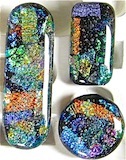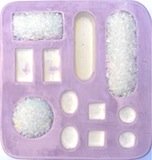Dichroic Cast Cabochons
Creating dichroic cast cabochons in a commercial glass fusing mold
These fused cabochons are made from black glass, black dichroic and clear medium frit.
Small pieces of black are used to line the bottom of the mold, and then dichroic is placed over this.
Clear medium frit is used as a cap.
The fused cabochons can be made from Bullseye or System 96.

Cutting:
There are a number of ways to make the small black items.
You can cut them with a glass cutter, break them off with grozing pliers or use wheeled mosaic nippers.
It can be easier to use wheeled mosaic nippers as you can nip the pieces in half very quickly if you need to.
Safety glasses must be worn whilst cutting.
If you are, using mosaic nippers cut along the edge of the scrap so that you can control the size of the offcuts.
Try to hold your hand around the edge so that the offcuts fall into your hand.
If you have a pair of safety gloves wear one on the hand catching the bits, many nipped pieces will have needle sharp ends.
Use tweezers when placing offcuts into mold.
On a general note wheeled glass nippers are a very handy tool to have in your tool kit, glass rods can be nipped to length, pieces easily cut from scrap, or strips can be quickly nipped into lengths, these are just a few of the jobs these nippers will do.
Wash and dry the scrap before cutting, it is very difficult to clean the cut pieces. Try not to hold the scrap in the areas that you are cutting.
Material Required:
Black dichroic glass
Scrap black glass
Clear medium frit
Wheeled mosaic nippers or grozing pliers.
Cutter.
Fusing mold.
Kiln Wash.
Fusing kiln.
Proceed As Follows:
Step 1. Apply kiln wash to fusing mold.
Step 2. Cut scrap into small pieces.

Step 3. Place cut black scrap into bottom of dry mold.
Step 4. Place dichroic over bottom layer, dichro' side uppermost.
Step 5. Clear medium frit is then placed over the dichro', mound up in the centre to allow for shrinkage.
With a small brush make a channel about 1/8' wide around the top edge of each filled cavity, brushing the frit towards the center.
This is done to minimize spikes around the top edge of the cabochon.
Fusing:
Step 6. Place into glass fusing kiln on small posts to ensure air circulation around the mold and fire as follows for System 96,for Coe 90 increase by 25 F (15 C):
300 F (150C)/hour up to 1470 F (775 c).
Hold 30 minutes.
Check to ensure that casting is fully fused.
If the top is not completely smooth, you may need to refire until it is smooth and level.
If fusing is complete turn off kiln.
Allow to cool to room temperature and then remove.
Check cast cabochons for spikes as castings can quite often have spikes around the upper edge.
If any spikes are present, remove with grinder or abrasive pad.
Clean completely and place back in kiln, fire polish to remove abrasive marks.
Do not place back in mold as the marks may not be removed.
Use prepared kiln shelf for this process, monitor closely as the items will spread if they are over heated.
Once completed you should have an original item with the layered pieces of dichro' clearly visible.
The cast items are ideal to use in many creative designs.
Return From Dichroic Cast Cabochons To Glass Jewelry Projects
Return To Home Page



